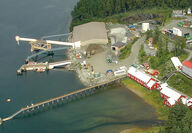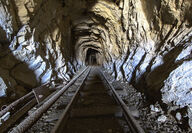Sorted by date Results 26 - 50 of 53

An abnormally long fall has allowed the Alaska mining industry to extend seasonal work well into mid-October, creating a lot of new information about project work conducted around the state. Exploration efforts, in particular, benefitted from this additional field time. Based on information available to date, 2019 exploration expenditures are expected to be in the $135-140 million range, well ahead of the $120-125 million exploration spending tracked for 2018. In addition,...

Ucore Rare Metals Inc. Oct. 15 announced that 38,500 metric tons of critical minerals have been added to the resource for its Bokan Dotson-Ridge rare earth project in Southeast Alaska. The new metals added as co-products to the REEs already defined at Bokan include niobium, zirconium, beryllium, hafnium, titanium and vanadium. Using a cut-off grade of 0.4 percent for the rare earths, the Bokan deposit hosts 4.79 million metric tons of indicated resource averaging 460 parts per...

Australia-based Northern Cobalt Ltd. has agreed to invest as much as US$20 million over the next four years to earn up to a 60 percent interest in Millrock Resources Inc.'s enormous land package covering highly prospective gold targets in Alaska's Goodpaster Mining District. Goodpaster has gained a lot of attention since Northern Star Resources Ltd.'s 2018 purchase of the Pogo gold mine at the heart of the district. While it has been just over a year since the acquisition,...

Yukon Territory, a mineral exploration frontrunner in Canada's North, is witnessing a significant slowdown in 2019. As a result, growth in Yukon's economy is expected to slow this year but rebound in 2020, according to The Conference Board of Canada. In its "Territorial Outlook Economic Forecast: Summer 2019," released in June, the board said new mines coming online in 2020 will drive Yukon's growth in the near future. Several factors, however, have converged to put the...

Earlier this month S&P Global put out a summary indicating that during the first quarter of 2019 metals like copper, zinc and nickel were up quarter over quarter by 11 percent, 22 percent and 25 percent, respectively. More recently gold has skyrocketed beyond the $1,400-per-ounce mark for the first time in many months. Correspondingly, the mining industry's aggregate market cap also rebounded strongly in the period after four bearish quarters, rising 12 percent to $1.43...

As is usually the case this time of year, the mining industry is awash in backward-looking statements designed to allow for more accurate forward-looking statements. Prime among them is one of my favorites, S&P Global's annual "World Exploration Trends 2019", a summary of what happened industry-wide in 2018 and what it may portend for the mining industry in 2019. The study predicts that global exploration budgets will increase again in 2019, although by a smaller amount, with...

Seeking economic and cultural prosperity for its more than 22,000 Tlingit, Haida and Tsimshian shareholders while also looking to provide even greater benefits for future generations, Sealaska takes a balanced approach to developing the resources growing above and stored beneath its lands in Southeast Alaska. This does not mean the Southeast Alaska Native Claims Settlement Act (ANCSA) corporation shuns mining or other resource development in its region, a nearly 600-mile...

The value of non-fuel metals produced in Alaska and the United States during 2018 were similar to 2017, according to Mineral Commodity Summaries 2019, an annual report published by the U.S. Geological Survey. Alaska mines produced roughly $3.44 billion worth of non-fuel minerals last year, down nearly 3 percent from the US$3.53 million in 2017. This slight drop is largely due to lower output from the two largest mines in the state – Fort Knox and Pogo. The roughly 1.4 b...

In addition to being a past producer and a future source of most of the 35 minerals and metals considered critical to the United States, Alaska currently contributes a globally significant amount of one of these vital metals – germanium. While not a widely known metal, germanium has optical qualities that make it an important ingredient in fiber-optics, infrared optics, electronics and solar energy systems. "The extensive use of germanium for military and commercial a...

With nearly indistinguishable physical and chemical properties, niobium and tantalum are almost always found together in nature. Both are also critical to the defense, energy and high-tech sectors in the United States, but neither are mined domestically. For these reasons, the United States Geological Survey considers these transition metals "indispensable twins" that are critical to America's economic and strategic wellbeing. "Niobium and tantalum are transition metals that...

With a melting point of 5,756 degrees Fahrenheit and a heat-stable crystalline structure, rhenium is extremely resistant to both heat and wear. This durability makes it a vital element in superalloys used in jet and industrial gas turbine engines. "The high-temperature properties of rhenium allow turbine engines to be designed with finer tolerances and operate at temperatures higher than those of engines constructed with other materials," the United States Geological Survey...

Titanium conjures images of the durable and lightweight metal used to build aircraft, replacement hips, high-end bicycle frames and even quality golf clubs. While its outstanding weight-to-strength ratio and corrosion resistance makes this critical metal ideal for these applications, roughly 93 percent of the world's titanium is used to impart a stark whiteness to many of the consumer goods we use every day. "Titanium is different than most other metallic elements in that it...

While not the flashiest of the 35 minerals on the United States Geological Survey's critical list, barite plays an essential role in America's energy sector. Barite got its name from the Ancient Greek word for heavy, barús, and it is the high specific gravity that earned this mineral its name that makes it a critical mineral. Added to drill mud, a solution that serves multiple purposes in bore drilling, barite's weight helps maintain the integrity of the drill hole and...

Strategic Metals Ltd. Aug. 20 reported that it is granting Vanadium North Resources Inc. the option to purchase in the Van project in western Northwest Territories. Located about 10 road-kilometers (six miles) north of the past producing Cantung tungsten mine, the 38-square-kilometer (14.7 square miles) Van property hosts a major sediment-hosted vanadium prospect that has not seen focused exploration since 1985. Currently, vanadium is primarily used as an alloy metal. In this...

A vital ingredient in stainless steel and superalloys, chromium is considered by the United States Geological Survey as "one of the Nation's most important strategic and critical materials." "Because there is no viable substitute for chromium in the production of stainless steel and because the United States has small chromium resources, there has been concern about domestic supply during every national military emergency since World War I," the USGS explains. Rich chromite...

In a report published in December, the United States Geological Survey defined critical minerals as non-fuel minerals or mineral materials essential to the economic and national security of the United States; vulnerable to supply chain disruptions; and serve an essential function in the manufacturing of a product, the absence of which would have significant consequences for the U.S. economy or security. Using this definition, USGS has identified 35 minerals critical to the...

Cobalt is an essential ingredient to optimizing the performance of batteries in the growing number of electric vehicles on global highways, yet essentially none of this battery metal is mined in the United States. With at least one advanced stage exploration project in Alaska looking into the potential of producing cobalt alongside its copper, America's 49th State could provide a domestic source for this critical metal. In its annual report, Mineral Commodity Summaries 2018,...

Primarily associated with cans, cups and roofs, tin may not be the flashiest metal on the market, but it has been a strategic metal that has defined human progress since the onset of the Bronze Age around 5,500 years ago and is on the list of minerals critical to the security of the United States even today, according to the U.S. Geological Survey. "In a congressionally mandated U.S. Department of Defense study of strategic minerals published in 2013, tin was shown to have...

Graphite is among the 23 metals and minerals the U.S. Geological Survey deemed critical to "the national economy and national security of the United States" in a December report, "Critical Mineral Resources of the United States – Economic and Environmental Geology and Prospects for Future Supply." One of the reasons the USGS considers graphite critical is the growing demand of this mineral as anode material in the lithium-ion batteries that power electric vehicles and a r...

The Trump Administration's focus on securing domestic sources of critical minerals could help re-invigorate mineral exploration and mine development in Alaska. At least 15 of the 23 critical minerals identified by the U.S. Geological Survey – antimony, barite, beryllium, cobalt, fluorspar, gallium, germanium, graphite, indium, platinum group elements, rare earth elements, rhenium, tantalum, tellurium, tin and vanadium – are found across the Far North state. Working alo...

Whether it be precious metals such as gold and silver, base metals like copper and zinc, or battery metals like nickel and cobalt, northern British Columbia is rich in the type of metal deposits that junior mining companies are hoping to discover and majors are wanting to mine. Couple this mineral endowment with good infrastructure – especially stacked up against the other jurisdictions in the North of 60 Mining News coverage area – and northern B.C. continues to draw str...

With nearly indistinguishable characteristics, niobium and tantalum are considered the "indispensable twins" among the 35 minerals and metals considered critical to the United States. "Niobium and tantalum are transition metals that are almost always found together in nature because they have very similar physical and chemical properties," the U.S. Geological Survey wrote in a 2018 paper on the twin metals. While nearly identical twins, they each have their own set of unique...

With more than 100 known tin occurrences, Alaska is considered the best place in America to establish a domestic source of this critical alloy metal that has defined human progress since the dawn of the Bronze Age. "Today, Alaskan tin deposits are known to be widespread, occurring from the central Alaska Range north to the Brooks Range and across Interior Alaska ... Southwest Alaska and the Seward Peninsula," according to the 1997 publication, Mineral Deposits of Alaska. And...

Titanium conjures images of the durable and lightweight metal used to build aircraft, replacement hips, high-end bicycle frames and even quality golf clubs. While its outstanding weight-to-strength ratio and corrosion resistance makes this critical metal ideal for these applications, roughly 93 percent of the world's titanium is used to impart a stark whiteness to many of the consumer goods we use every day. "Titanium is different than most other metallic elements in that it...
Strategic Metals Ltd. has more than 100 mineral properties in the Yukon, making it the largest claim holder in the territory. These properties, along with projects it has in neighboring Northwest Territories and northern British Columbia, are prospective for gold, silver, lead, zinc, copper, tin, tungsten, vanadium and lithium. The company started off its 2016 exploration by acquiring additional information at some of its most prospective gold projects in Yukon. The work included trenching at OOO, a silver-gold property...